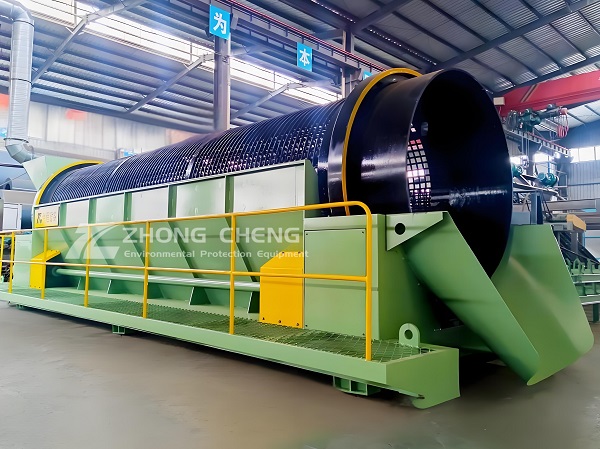
Rotating trommel screen is an efficient screening equipment, the core of which is the "rotary screening" mechanism. The equipment is composed of inclined cylindrical screen, which is driven by the motor to rotate the cylinder, so that the materials are continuously rolled under the action of centrifugal force and gravity, so as to realize the natural separation of materials with different particle sizes. The rotary roller screen has the advantages of high screening efficiency, flexible particle size adjustment, wide application range, etc., and is widely used in construction waste treatment, ore screening and other fields.
Rotary Trommel screen is an efficient screening equipment, playing an important role in many industries such as construction, mining, environmental protection, etc. The following is a detailed description of the rotary drum screen.
Rotary Trommel Screens consist essentially of one or more cylindrical screens mounted on an inclined frame and driven by an electric motor to rotate. The materials enter from one end of the trommel. With the rotation of the trommel, the materials are continuously rolled and moved under the action of gravity and centrifugal force. In this process, particles smaller than the mesh size pass through the screen and become undersize product, while particles larger than the mesh size are retained on the screen and eventually discharged from the other end of the drum as oversize product. By adjusting the size of the sieve, the particle size of the screened material can be controlled to meet different production requirements.
Performance characteristics
High screening efficiency: rotating trommel screen can quickly and accurately classify materials according to particle size, greatly improving the efficiency of subsequent processing steps. Due to its large screening area and high processing capacity, the rotary drum screen can meet the screening requirements of large-scale production.
Good stability: the rotating motion of the trommel keeps the material in dynamic balance during the screening process, effectively preventing material blockage and screen damage. This stability not only improves the screening efficiency, but also prolongs the service life of the equipment.
Multi-functionality: rotary trommel screen is applicable to various types of materials, including concrete, brick and tile, wood, metal, ore, sand, etc. By changing screens with different apertures, it can adapt to different screening requirements and handle materials with various particle sizes.
Strong durability: For sharp objects (such as rebar, brick fragment and stone) that may exist in the materials, the rotary trommel screen is made of high-strength wear-resistant materials to ensure long-term stable operation. At the same time, the equipment design considers the convenient replacement and daily maintenance requirements of vulnerable parts, reduces the downtime and improves the production efficiency.
Environmental protection measures: the rotary trommel screen is equipped with a dust removal device to effectively reduce the dust pollution generated in the screening process and improve the working environment. In addition, the fully sealed structure also reduces the emission of noise and dust, meeting the environmental protection requirements.
Application Scenario
Construction waste treatment: rotary trommel screen can be directly used on the construction site to quickly clean and classify the waste construction materials. At the same time, it can also be used as a part of the construction waste comprehensive treatment line in conjunction with other equipment (such as crusher, magnetic separator, etc.) to achieve resource recovery and reuse.
Ore screening: rotary trommel screens are used in the mine industry to improve ore grade and recovery. Through screening, the useful and useless components in the ore can be separated to provide high-quality raw materials for subsequent processing.
Application in environmental protection industry: in environmental protection industry, rotary drum screen can be used for the screening of solid waste and sludge in sewage treatment plant. Through screening, the useful components in sludge can be recovered, and the discharge of sludge and environmental pollution can be reduced.
Application in other industries: In addition, rotary trommel screen is widely used in chemical industry, agriculture, food and other industries. In the chemical industry, it can be used for screening raw materials and catalysts, etc; In the agricultural industry, it can be used to screen fertilizers and feed; In the food industry, it can be used to screen raw materials and finished products.
Maintenance and service
In order to ensure the long-term stable operation of the rotary drum screen, regular maintenance is required. These include:
Regular inspection: regularly check whether all parts of the equipment are in good condition, and replace in time in case of damage or wear.
Cleaning: regularly clean the debris and blockage on the screen to keep the screen unblocked.
Lubrication maintenance: regularly lubricate and maintain the bearings, gears and other parts of the equipment to reduce wear and faults.
Safety protection: when operating the equipment, the safety operation regulations shall be strictly observed to ensure the safety of personnel and equipment.
With its unique working principle and superior performance, rotary trommel screen plays an irreplaceable role in many industries. It plays an important role in both industrial production and resource recovery.
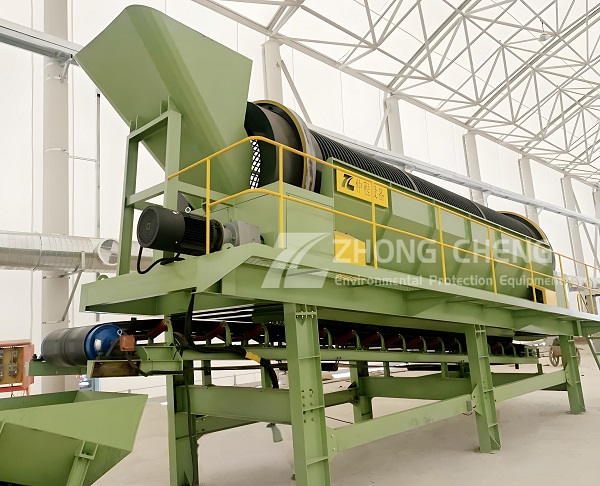
1. Consider the characteristics of the material to be processed: Particle size distribution: The particle size of the material directly affects the screening efficiency. It is necessary to select the appropriate mesh size according to the particle size distribution of the material to achieve the best screening effect. Humidity and viscosity: High humidity or sticky materials may cause the mesh to be blocked. Therefore, for such materials, a drum screen with a special design (such as an internal knocking device) should be selected to prevent the material from sticking and blocking the mesh.
2. Consider the production capacity of the drum screen: Processing volume requirements: Determine the diameter and length of the drum screen according to the required processing volume. The processing capacity should match the production requirements to avoid equipment waste or insufficient processing capacity. Screening efficiency: Screening efficiency is an important indicator to measure the performance of the drum screen. Equipment with high screening efficiency and strong processing capacity needs to be selected to meet production needs.
3. Consider the screening accuracy of the drum screen, such as the mesh specifications: The mesh specifications directly affect the screening accuracy. It is necessary to select the appropriate mesh specifications according to the particle size requirements of the final product to ensure that the particle size of the product after screening meets the requirements. Multi-stage screening: For materials that require multi-stage screening, a drum screen with multiple layers of screens can be selected to achieve graded screening of different particle sizes.
4. Consider the size and site limitations of the drum screen, including installation space: Before selecting a drum screen, the size of the installation space and the size of the equipment must be considered to ensure that the equipment can be installed smoothly and is convenient for daily maintenance and operation. Body height limit: The body height limit of the equipment must be considered to ensure that the equipment can adapt to the site environment and is easy to operate. 5. Consider the energy consumption of the drum screen and local environmental protection requirements. Energy consumption: Choosing a drum screen with low energy consumption helps reduce production costs. It is necessary to pay attention to the energy consumption indicators of the equipment and select equipment with good energy-saving effects. Environmental protection requirements: It is necessary to select a drum screen that meets environmental protection standards to reduce dust emissions and noise pollution and meet environmental protection requirements.
6. Automation degree and technical support. With the development of automation technology, many drum screens are equipped with automatic control functions. It is necessary to select equipment with an appropriate degree of automation according to actual needs to improve work efficiency and screening accuracy.
When choosing a rotary drum screen, you need to consider material characteristics, production capacity, screening accuracy, equipment size and site restrictions, energy consumption and environmental protection requirements, economy and reliability, as well as automation and technical support. By comprehensively evaluating these factors, you can choose the rotary drum screen that best suits your production needs.
Made of high-quality materials, it has a sturdy and durable structure, high screening efficiency and precision. With advanced design, stable operation and easy maintenance, it is suitable for screening a variety of materials, showing excellent screening performance and long-term reliability, and is the preferred equipment in the field of industrial screening.
We customize screening equipment according to customer needs. We consider factors such as material characteristics, screening accuracy, and processing capacity to design suitable sizes, materials, and screens. We ensure efficient screening and stable operation to meet personalized production needs.
It has the characteristics of efficient screening, large processing capacity and stable operation. It has high screening accuracy and is suitable for a variety of materials; its processing capacity can reach hundreds of tons per hour, meeting the needs of large-scale production; it has stable operation, low noise and easy maintenance, making it the preferred equipment in the field of industrial screening.
It has a wide range of material adaptability, high screening efficiency and large processing capacity; it has a sturdy and durable structure, stable operation and low noise; it is easy to maintain, can be customized according to the particle size of the material, and can flexibly adapt to a variety of working environments and needs. It is the preferred equipment for achieving efficient screening.
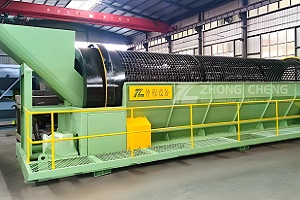
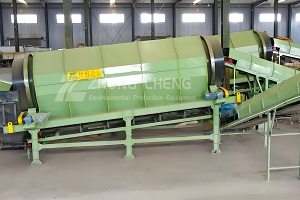
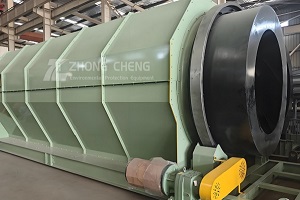
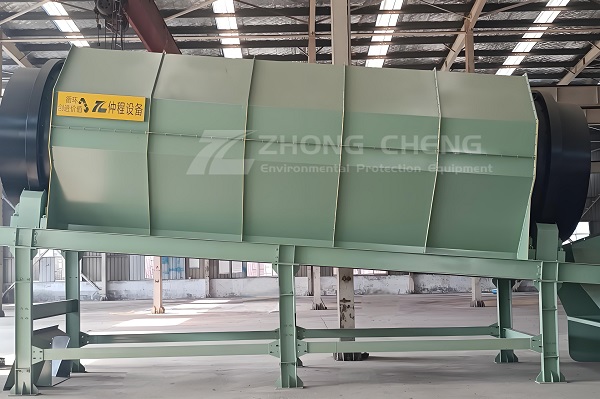
The rotary trommel screen is an efficient and multifunctional screening equipment. Its working principle is relatively simple and efficient. The following is a detailed description of its working principle:
The core components and structure of the rotary trommel screen
The core component of the rotary trommel screen is a trommel installed obliquely or horizontally, and the surface of the trommel is covered with sieve holes of different sizes and shapes. The trommel is usually made of high-quality steel plate or wear-resistant alloy material, and a screen or sieve plate is welded on the surface. The size and shape of these sieve holes are determined according to the characteristics and needs of the screened materials.
The working principle of the rotary trommel screen
The working principle of the rotary trommel screen mainly depends on the rotation of the trommel. When the trommel rotates driven by the drive device, the material enters from one end of the trommel. With the rotation and tilt angle of the trommel, the material continues to roll, throw and fall in the trommel. In this process, material particles smaller than the size of the sieve hole will leak out through the sieve hole and become the under-screen product; while the material larger than the size of the sieve hole will continue to roll along the trommel and eventually be discharged from the other end of the trommel to become the over-screen product.
Specifically, after the material enters the trommel, it begins to move along the axis of the trommel under the combined action of gravity and centrifugal force. At the same time, due to the rotation of the trommel, the material is constantly tumbling and tossed in the trommel, increasing the contact opportunity between the material and the screen, thereby improving the screening efficiency. In this process, particles smaller than the screen aperture will pass through the screen and fall into the collection device below, while particles larger than the screen aperture will be left on the screen and continue to move forward with the rotation of the trommel.
Screening effect and adjustment of rotary trommel screen
The screening effect of rotary trommel screen mainly depends on the speed of the trommel, the inclination angle, the size of the screen hole and the characteristics of the material. By adjusting these parameters, the screening and separation of materials of different particle sizes and types can be achieved. For example, when finer materials need to be screened, a smaller screen hole and a higher speed can be selected; when coarser materials need to be screened, a larger screen hole and a lower speed can be selected.
The rotary trommel screen also has a self-cleaning function. During the screening process, the continuous tumbling and tossing of the material can effectively prevent the screen from being blocked. At the same time, some trommel screens are also equipped with special cleaning devices, such as scrapers or brushes, which are used to regularly clean impurities and blockages on the screen to keep the screen unobstructed and clean.
Rotary trommel screens have been widely used and recognized in many industries for their high efficiency, stability, and strong adaptability.

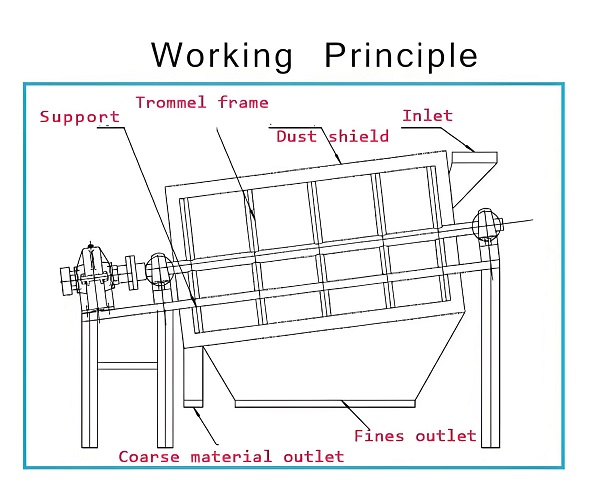
| Model | Drum specifications (diameter × length) | Tilt angle | Speed (r/min) | Sieve size range (mm) | Maximum feed particle size (mm) | Processing capacity (m³/h) | Motor power (kW) | |
|---|---|---|---|---|---|---|---|---|
| Sieve hole 2-30mm | Sieve hole 5-60mm | |||||||
| GTS-0515 | Φ500×1500 | 5°-7° | 22-25 | 1-50 | ≤60 | 5-50 | - | 0.75-2.2 |
| GTS-0824 | Φ800×2400 | 20-22 | ≤70 | 10-80 | 3-4 | |||
| GTS-1030 | Φ1000×3000 | 22.5 | ≤60 | 10-60 | 4 | |||
| ≤60 | 60-80 | |||||||
| GTS-1236 | Φ1200×3600 | 17-20 | ≤70 | 12-100 | 5.5 | |||
| ≤70 | 100-120 | |||||||
| GTS-1540 | Φ1500×4000 | 17 | 2-30 | ≤80 | 18-150 | - | 7.5-11 | |
| ≤80 | 150-180 | |||||||
| GTS-2050 | Φ2000×5000 | 12 | 5-60 | ≤90 | - | 25-300 | 15-18.5 | |
| ≤90 | 300-350 | |||||||
*The output will vary according to different materials, feed particle size and other factors.
Save Time! Get A Detailed Quotation Quickly.
